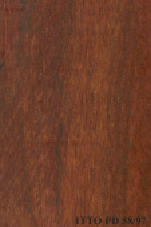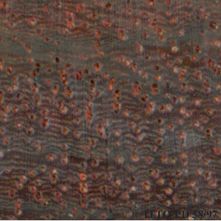
PADOUK D`AFRIQUE (Pterocarpus tinctorius)
Trade Name
Padouk d`Afrique
Scientific Name
Pterocarpus tinctorius Welw.
Family
LEGUMINOSAE
Common Names
Paduk (Italy); Padoek (Netherlands); Padouk (Germany); Barwood (United Kingdom); Camwood (United Kingdom); African Padauk (United Kingdom); Padauk (United Kingdom); Corail (Belgium); Mongola (Zaire); Mukula (Zaire); N`gula (Zaire); Kisese (Congo); Mbel (Gabon); Mbel (Cameroon); Osun (Nigeria); Nkula (Zaire); Tacula (Angola); Palo rojo (Equatorial Guinea)
Scientific Name Synonyms
Pterocarpus zimmermannii Harms; Pterocarpus velutinus De Wild.; Pterocarpus tinctorius var. macrophyllus Welw. ex Baker; Pterocarpus tinctorius var. odoratus (De Wild.) Hauman; Pterocarpus tinctorius var. chrysothrix (Taub.) Hauman; Pterocarpus odoratus De Wild.; Pterocarpus megalocarpus Harms; Pterocarpus kaessneri Harms; Pterocarpus holtzii Harms; Pterocarpus hockii De Wild.; Pterocarpus delevoyi De Wild.; Pterocarpus chrysothrix Taub.; Pterocarpus cabrae De Wild.; Pterocarpus albopubescens Hauman; Lingoum tinctorium (Welw.) Kuntze
Description Of The Tree
Botanical Description
The bole is usually straight and cylindrical, up to 15 m long. It presents low buttresses or no buttresses at all. Log is banned for international trading.(Cameroon)
Natural Habitat
Pterocarpus tinctorius occurs in riparian forests, secondary formations and grass savanna.
Wood Identification
Anatomic Description Of Wood
Vessels per mm2 less than 6 (rare). Wood diffuse porous. Occasionally vessels exclusively solitary (over 90%). Tangential diameter of vessel lumina 200 micras or more (large). Vestured pits. Simple perforation plates. Intervessel pits large, 10 micras or more. Paratracheal axial parenchyma scanty and/or vasicentric. Axial parenchyma aliform. Axial parenchyma confluent. Axial parenchyma in marginal or in seemingly marginal bands. Prismatic crystals in short chains in chambered axial parenchyma cells. Two cells per pa Rays exclusively uniseriate. Non-crystals in ray cells. Homogeneous rays and/or sub-homogeneous rays (all ray cells procumbent). Non-septate fibers. Fibers with simple to minutely bordered pits.
-
 Wood Macro Photo Tangential Plane
Wood Macro Photo Tangential Plane
-
 Wood Micro Photo Of Transversal Section
Wood Micro Photo Of Transversal Section
Availability
Cites Status
Unrestricted
General Wood Description
COLOR INDEX (1=Black, 7=Light yellow,white)
2
Grain
Wavy; special care is needed when machining in order to obtain satisfying quality surface.
Texture
The wood is mostly coarse in texture.
Luster
The wood luster is reported to be rather low.
Natural Durability
Moderately durable to decay. Without preservative treatment, this species can be used only under risk of occasional re-humidification. It is not suited for uses with risks of permanent or long-lasting humidification. Resistant to termites attacks.
Natural durability index (1= Very high durability, 7=Vey low durability)
1
Internal Growth Stresses
No residual stresses are reported in this species.
Silica Content
Silica Content: Negligible content of silica is reported. Amounts over 0.05% may affect wood processing. Silica Value: 0
Resistance To Impregnation
Difficult to treat with only a low penetration of the preservative products.
Wood Physical Properties
Basic Density or Specific Gravity (O.D. weight/vol. green) (g/cm³)
0.80
Air-dry Density (Weight and volume at 12%MC) (g/cm³)
0.92
Total shrinkage Tangential (Saturated to 0%MC) (%)
5.2
Total shrinkage Radial (Saturated to 0%MC) (%)
3.3
Drying Defects
Ease of Drying: Drying is very slow and difficult to perform; defects are frequent. Drying Defects: Risks of distortions. Kiln Schedules: Schedule proposed as a reference by comparison with well known species taking into account to the general technological behavior of this species.
Recommended Dry Kiln Schedule
FR-4
Dimensional stability ratio (Total Tangential Shrinkage %/Total Radial Shrinkage %)
1.6
Wood Chemical Properties
Wood Mechanical Properties
Bending Strength (MOR),12%MC (kgf/cm²)
1064
Stiffness (MOE) 12%MC (kgf/cm²)
190955
Compression parallel to fiber 12%MC (kgf/cm²)
795
Compression perpendicular to fiber 12%MC (kgf/cm²)
115
Shear strength radial 12%MC (kgf/cm²)
52
Janka hardness (side) 12%MC (kgf)
1063
Janka hardness (end grain) 12%MC (kgf)
1098
Workability
Rotary Veneer Cutting
Suitable for slicing.
Sliced Veneer
Suitable for slicing.
Blunting Effect
Moderate blunting effect; stellited blades for sawing and carbide tools for machining are advised.
Planing
Moderately easy; tools must be cautiously sharpened.
Moulding
Easy; no particular problems.
Turning
30
Boring
Easy; no particular problems.
Mortising
Easy; no particular problems.
Nailing
Pre-boring is necessary.
Gluing
Difficult to glue because of the extracts content.
Sanding
Easy to perform; it gives good results.
Polishing
Needs pre-coating.
REFERENCED USES
End Uses Summary
HOUSING GENERAL, beams, joists, boards, flooring, parquet, frames, steps, panelling, fittings, FURNITURE AND CABINETS, luxury furniture, cabinets, PLYWOOD AND VENEER, Decorative veneer, TURNING, ornaments, turned furniture, cutlery, lasts, CONTAINERS, truck bodies, truck flooring, NAVAL CONSTRUCTION, boats, boat hulls, boat deck, port storage, OTHER AND MUSICAL INSTRUMENTS, handicrafts
General Housing
- 10 - Silica in Timbers
Beams
- 11 - Prospect: The wood database
Joists
- 12 - Tropical timbers of the world. Part I-Tropical American Species
Boards
- 13 - Dry kiln schedules for commercial woods. Temperate and tropical. Section III. Latin American (Mexico, Central, and South America) Woods–Conventional Temperatures
Flooring
- 14 - Handbook of Hardwoods
Parquet
- 15 - Empire Timbers
Frames
- 16 - Woods of the World
Steps
- 17 - Tree Conservation Database
Paneling
- 18 - W3TROPICOS Missouri Botanical Garden
Fittings
- 19 - Silica in Timbers
Furniture Cabinets
- 21 - Tropical timbers of the world. Part III-Southeast Asian and Oceanian Species.
Furniture, Luxury
- 22 - Dry kiln schedules for commercial woods. Temperate and tropical. Section IV-Asian and Oceanian Woods
Cabinet
- 24 - Empire Timbers
Panels, Veneers
- 25 - Directory of Timber Trade Malaysia
Decorative veneer
- 28 - Ministry of Agriculture, Fisheries & Forest of Fiji
Turning
- 30 - Embassy of Honduras in Japan
Ornaments
- 31 - Embassy of Colombia in Japan
Turned Articles
- 32 - Embassy of Cote d`Ivoire in Japan
Knife Handles
- 33 - Embassy of Gabon in Japan
Lasts
- 34 - Embassy of Indonesia in Japan
Truck Body
- 53 - Timbers of the New World
Truck Flooring
- 54 - Bulletin of the Government Forest Experiment Station N.157: Identification of Tropical Woods
Shipbuilding
- 55 - Tropical Timber Atlas of Latin America
Boats
- 56 - Manual de Identificación de Especies Forestales de la Subregión Andina.
Boat Hulls
- 57 - Estadísticas de Aprovechamiento, Exportación y comercialización Nacional de Productos Forestales
Boat Decking
- 59 - Programa Nacional de uso Sostenible de los Bosques e Incremento a las Exportaciones.
Port Storage
- 62 - Estudio Tecnológico de Maderas del Perú (Zona Pucallpa) Vol I
Handcraft
- 66 - Maderas latinoamericanas. VII. Caracteristicas anatomicas. propiedades fisicomecanicas, de secado, y tratabilidad de la madera juvenil de Cordia alliodora (Ruiz & Pav. Oken.)
Please Provide Information To View Producer Information